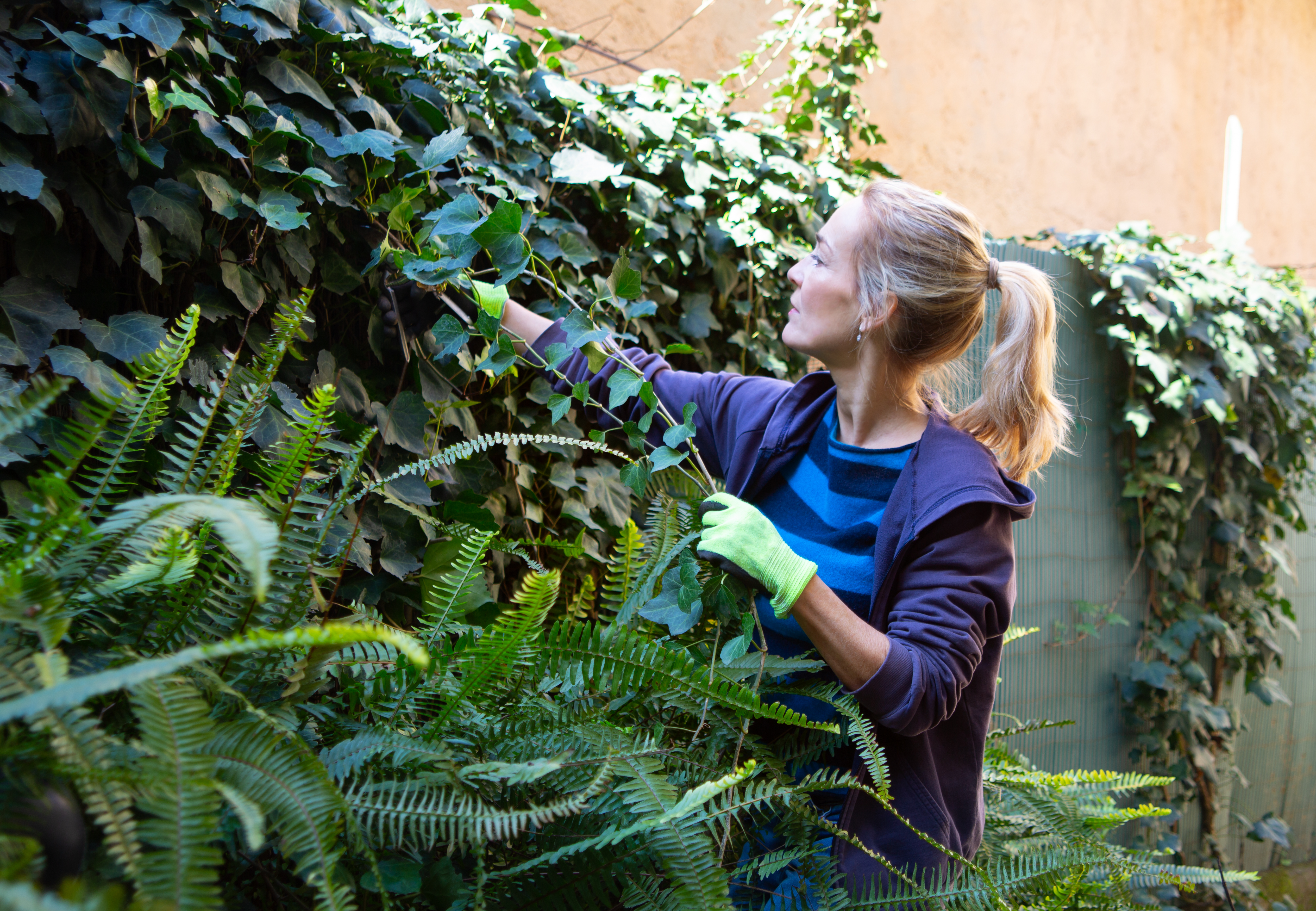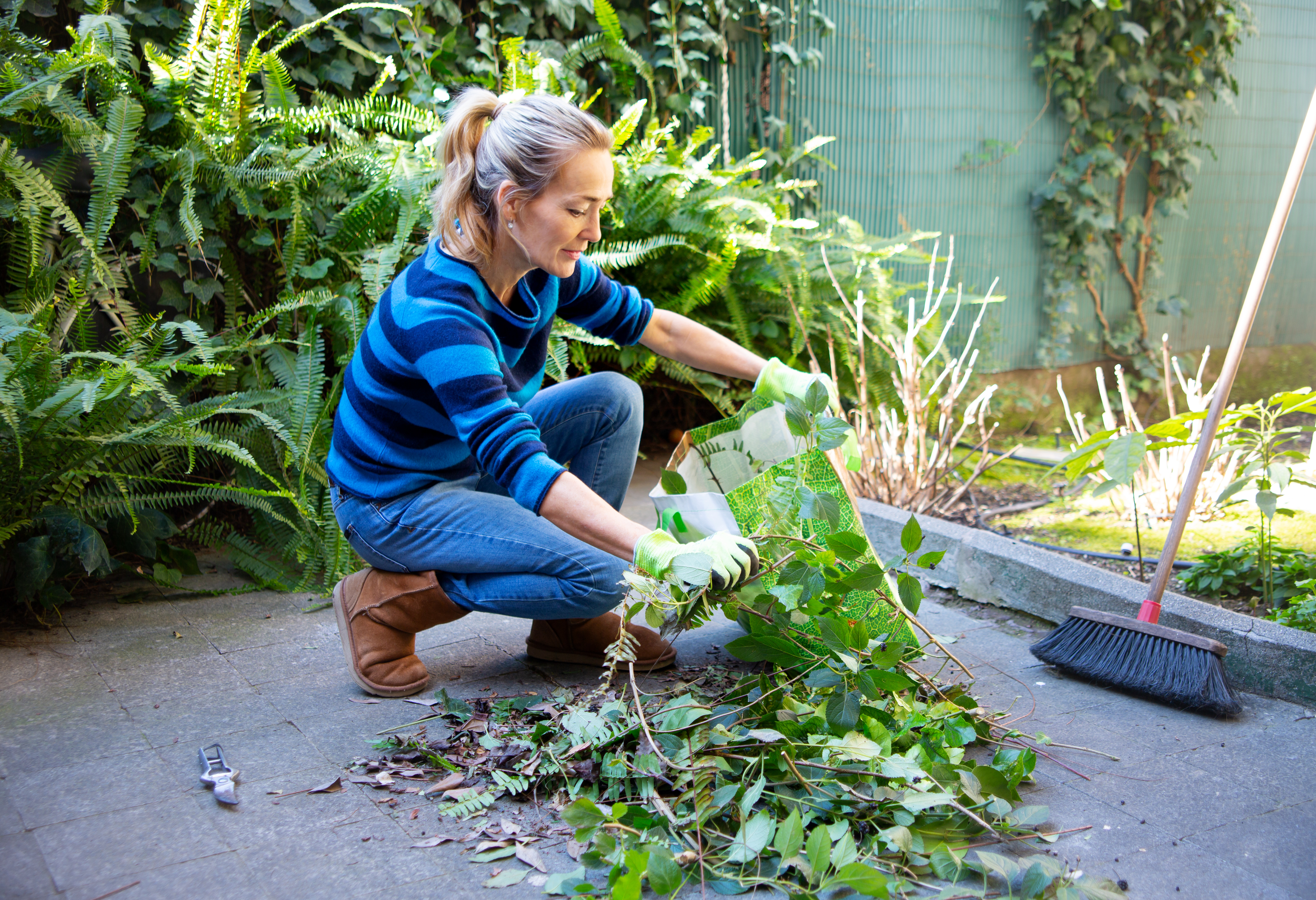

We may earn revenue from the products available on this page and participate in affiliate programs. Learn More ›
Characterized by its showy, star-shaped foliage, English ivy (Hedera helix) might seem a fine choice for landscaping as a potted plant, ground cover, or groomed exterior wall accent—but don’t let down your guard just yet. Left unchecked, the evergreen perennial can become an invasive enemy to your yard. Ivy knows no bounds: It grows quickly in all directions, both horizontally and vertically, clinging to other vegetation and depriving it of all sunlight. If the vining plant doesn’t smother and kill trees, shrubs, and grass, it’ll infect them with rot or disease. If you’ve already seen such destruction, save your property from the aggressive greenery by following these steps for how to kill ivy and prevent its return.
Table of Contents
Tools & Materials
Bobvila.com may earn a commission from purchases made through these links.
Step 1: Protect yourself and your plants.
Suit up in gardening gloves, a long-sleeved shirt, and pants, because exposed skin may be irritated by the oil that ivy secretes. Choose a day when the temperature is between 60 and 90 degrees Fahrenheit, the temperature range in which topical chemicals used for killing ivy are effective. You’ll also want to work on a day with minimal wind in order to prevent chemicals from blowing onto nearby gardens and landscaping.

Tried-and-True Advice
“If you keep an organic garden and don’t use chemical herbicides, I find tarping works well against many aggressive plants, including English ivy. After physically removing as much ivy as possible, I cover up the affected area with dark-colored tarps or overlapping pieces of cardboard to ensure the ivy doesn’t creep back in. I leave this covering in place for about 6 to 8 weeks, and then plant or mulch over the area to keep the soil covered and prevent new weeds from sneaking in.”
—Lauren Landers, Contributing Writer
Step 2: Detach the ivy.

Detach the ivy from the surface that it’s covering, whether it’s across the lawn or up a tree.
- For ivy on the ground: You’ll need to use a tough brush cutter or a long, sharp pair of gardening shears to separate ivy from the ground. (Lawn mowers may shred the leaves but generally aren’t effective for attacking the vines.) Working in small sections a couple of feet wide, use the shears to cut straight through the ivy’s vine system where it meets the earth. Roll up each section like a rug, tugging and clipping with the shears or brush cutter along the way to entirely detach all pieces of ivy. Repeat as needed until all ivy has been sectioned and rolled. A word of caution: Ivy only needs one remaining vine to take root again, so take your time and don’t leave any pieces in your lawn.
- For ivy on trees: There’s no need to detach every strand on the trunk. In fact, since ivy clings to tree bark, removing it may harm the tree. Instead, concentrate only on detaching the 3 to 5 feet of foliage nearest the bottom of the tree, where the vine connects to its roots. Or, if the ivy doesn’t reach the ground, concentrate on the bottom 2 or 3 feet of the climbing vines. Separate the ivy from the tree with sharp shears, and take care not to cut into the bark, which will only weaken the tree further.
Step 3: Dispose of the ivy.

Bag up the ivy and throw it away. If you leave your detached ivy in clumps on your property, it can quickly snake its way back into the ground or up a tree trunk, undoing your hard work. (It can even take root in your compost pile, so don’t try to compost ivy!)
Step 4: Apply vinegar or herbicide.
Fill a spray bottle or pump sprayer with white vinegar and thoroughly spray the whole area from which you’ve just removed the ivy. For ivy on a tree, you’ll want to cover the bottom foot or so of the vines remaining on the tree.
Another way to kill ivy is to apply an herbicide made with glyphosate, imazapyr, triclopyr, or some combination of these chemicals. We never recommend using glyphosate, and strongly advise against using herbicides except as a last resort. Ortho GroundClear Vegetation Killer works well for the purpose, if you must use an herbicide.
Herbicide alone isn’t necessarily the best way to kill ivy, because the waxy cover on ivy leaves blocks the chemical from properly attacking the root system. By applying the deterrent soon after removing ivy from a tree or ground (Step 2), you can increase the effectiveness of the DIY or commercial herbicide.
Step 5: Monitor the area (and repeat Steps 2 through 4, if necessary).
Every two or three weeks, examine your property and make sure ivy vines haven’t popped up again. If you spot any new vines, pull them out with a gloved hand and gardening shears, then spray another dose of vinegar or herbicide to spot-treat the stems.
Note that if you intentionally grow English ivy as part of your landscaping, you should follow these guidelines to prevent it from overrunning the place: Keep the vines contained by surrounding them with mulch, and trim the edges whenever they begin to creep. Ivy can be a charming addition to any yard, but containment and maintenance are critical if you want your other vegetation to thrive alongside it.
